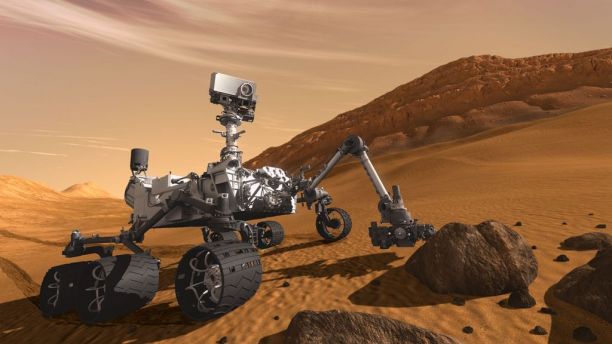The Curiosity rover remains perfectly on course to make its Monday (GMT) landing on the Red Planet, NASA says.
The NASA robot’s flight trajectory is so good engineers cancelled the latest course correction they had planned.
To be sure of touching down in the right place on the surface, the vehicle must hit a box at the top of the atmosphere that is just 3 km by 12 km.
“Our inbound trajectory is right down the pipe,” said Arthur Amador, Curiosity’s mission manager.
“The team is confident and thrilled to finally be arriving at Mars, and we’re reminding ourselves to breathe every so often. We’re ready to go.”
Curiosity’s power and communications systems are in excellent shape.
The one major task left for the mission team is to prime the back-up computer that will take command if the main unit fails during the entry, descent and landing (EDL) manoeuvres.

Curiosity – also known as the Mars Science Laboratory – has spent the past eight months travelling from Earth to Mars, covering more than 560 million km.
The robot was approaching Mars at about 13,000 km/h on Saturday. By the time the spacecraft hits the top of Mars’ atmosphere, about seven minutes before touch-down, gravity will have accelerated it to about 21,000 km/h.
The vehicle is being aimed at Gale Crater, a deep depression just south of the planet’s equator.
It is equipped with the most sophisticated science payload ever sent to another world.
Its mission, when it gets on the ground, is to characterize the geology in Gale and examine its rocks for signs that ancient environments on Mars could have supported microbial life.
Touch-down is expected at 05:31 GMT (06:31 BST) Monday 6 August; 22:31 PDT, Sunday 5 August.
It is a fully automated procedure. NASA will be following the descent here at mission control at the Jet Propulsion Laboratory in Pasadena, California.
The rover will broadcast X-band and UHF signals on its way down to the surface.
These will be picked up by a mix of satellites at Mars and radio antennas on Earth.
The key communication route will be through the Odyssey orbiter. It alone will see the rover all the way to the ground and have the ability to relay UHF telemetry straight to Earth.
And mission team members remain hopeful that this data will also include some images that Curiosity plans to take of itself just minutes after touching the ground.
These would be low-resolution, wide-angle, black and white images of the rear wheels.
They may not be great to look at, but the pictures will give engineers important information about the exact nature of the terrain under the rover.
A lot has been made of the difficulty of getting to Mars, and historically there have been far more failures than successes (24 versus 15), but the Americans’ recent record at the Red Planet is actually very good – six successful landings versus two failures.
Even so, NASA continues to downplay expectations.
“If we’re not successful, we’re going to learn,” said Doug McCuistion, the head of the US space agency’s Mars programme.
“We’ve learned in the past, we’ve recovered from it. We’ll pick ourselves up, we’ll dust ourselves off, we’ll do something again; this will not be the end.
“The human spirit gets driven by these kinds of challenges, and these are challenges that drive us to explore our surroundings and understand what’s out there.”
The mission team warned reporters on Saturday not to jump to conclusions if there was no immediate confirmation of landing through Odyssey.
There were “credible reasons”, engineers said, why the UHF signal to Odyssey could be lost during the descent, such as a failure on the satellite or a failure of the transmitter on the rover.
Continued efforts would be made to contact Curiosity in subsequent hours as satellites passed overhead and when Gale Crater came into view of radio antennas on Earth.
“There are situations that might come up where we will not get communications all the way through [to the surface], and it doesn’t necessarily mean that something bad has happened; it just means we’ll have to wait and hear from the vehicle later,” explained Richard Cook, the deputy project manager.
This was emphasized by Allen Chen, the EDL operations lead. His is the voice from mission control that will be broadcast to the world during the descent. He will call out specific milestones on the way down. He said there would be no rush to judgement if the Odyssey link was interrupted or contained information that was “off nominal”.
“I think we proceed under any situation as though the spacecraft is there, and there for us to recover – to find out what happened,” he said.
“That’s the most sensible thing to do. There are only a few instances I think where you could know pretty quickly that we’d be in trouble.”
